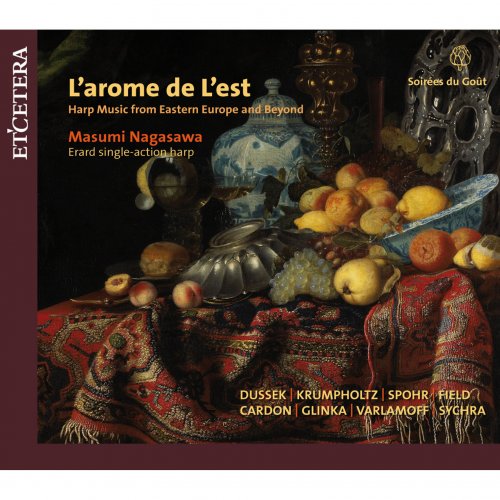
Masumi Nagasawa - L'arome de L'est: Harp Music from Eastern Europe and Beyond (2008)
BAND/ARTIST: Masumi Nagasawa
- Title: L'arome de L'est: Harp Music from Eastern Europe and Beyond
- Year Of Release: 2008
- Label: Etcetera
- Genre: Classical Harp
- Quality: flac lossless (tracks)
- Total Time: 01:16:01
- Total Size: 320 mb
- WebSite: Album Preview
Tracklist
01. Nocturne Separation / Razluka in F-Minor
02. 3 Sonatinas from The Six Sonatinas ded. to Madame Krumpholtz: Sonatina III, G- Major: Andantino poco Allegretto, Allegro non..
03. Sonate En Scene de Stile Pathétique, Op. 16 bis ded. to Madame la Comtesse de Rzewuska
04. Variations on The Theme of Ah, Vous Dirai-Je, Maman
05. Nocturne in E Flat Major
06. Sonatina VI in E Flat Major: Adagio, Tempo di menuetto
07. Variations on The Theme of Je Suis Encore Dans Mon Printemps
08. Sonatina II in F Major: Andante grazioso, allegro
09. Etude du Renforcement (Adagio from The Sonata, Op. 14)
10. Variations on The Russian Theme Au Milieu des Collines
11. Melodie
12. Sonata in F Minor: I. Allegro non troppo
13. Sonata in F Minor: II. Rondo-Allegretto
14. Nocturne in E Flat Major
Throughout the 18th century Bohemia’s finest musicians were emigrating to other countries. On the other hand, musicians from the west were traveling to Eastern European countries and beyond to expand their musical activities. The music scene everywhere was stirring with musicians from abroad. In Russia, Italian composers and music teachers who fled from the French revolution were contributing to music society there. Especially the Russian capital St. Petersburg with all its splendor and wealth, had a great attraction for talented musicians coming from Europe. From Krumpholtz to Glinka is a remarkable journey in the harp music history of the single-action harp. Through this journey one will be able to savour the aromas of the countries in which these composers have lived or traveled. While the history of the single-action harp slowly reached towards the end when Sebastien Erard invented the double-action harp in 1810, the melancholic resonance of the single-action harp still remained for a while until the middle of the 19th century. Who could ever forget so easily the infinite nuance and the delicate sound of the single-action harp? Masumi Nagasawaperforms on Modern Grand Harp, Single-action Harp (18th – 19th century historical harp), Irish Harp and Japanese Ancient Harp (Kugo). Her studies were concluded with the soloist diploma cum laude, followed by the Prix d'Excellence. In 1990, she received the Muramatsu Music Prize Grand Prix Japan, which is awarded to a highly prestigious musician. Masumi has given recitals in many international concert halls. She has been a soloist with the Concertgebouw Chamber Orchestra, the St. John's College Choir Cambridge, and also together with Dame Kiri te Kanawa and Cecilia Bartoli. Besides her performances, she has composed and arranged various pieces for the harp, which have been published and recorded. Currently she is teachingat the conservatory in Maastricht.
01. Nocturne Separation / Razluka in F-Minor
02. 3 Sonatinas from The Six Sonatinas ded. to Madame Krumpholtz: Sonatina III, G- Major: Andantino poco Allegretto, Allegro non..
03. Sonate En Scene de Stile Pathétique, Op. 16 bis ded. to Madame la Comtesse de Rzewuska
04. Variations on The Theme of Ah, Vous Dirai-Je, Maman
05. Nocturne in E Flat Major
06. Sonatina VI in E Flat Major: Adagio, Tempo di menuetto
07. Variations on The Theme of Je Suis Encore Dans Mon Printemps
08. Sonatina II in F Major: Andante grazioso, allegro
09. Etude du Renforcement (Adagio from The Sonata, Op. 14)
10. Variations on The Russian Theme Au Milieu des Collines
11. Melodie
12. Sonata in F Minor: I. Allegro non troppo
13. Sonata in F Minor: II. Rondo-Allegretto
14. Nocturne in E Flat Major
Throughout the 18th century Bohemia’s finest musicians were emigrating to other countries. On the other hand, musicians from the west were traveling to Eastern European countries and beyond to expand their musical activities. The music scene everywhere was stirring with musicians from abroad. In Russia, Italian composers and music teachers who fled from the French revolution were contributing to music society there. Especially the Russian capital St. Petersburg with all its splendor and wealth, had a great attraction for talented musicians coming from Europe. From Krumpholtz to Glinka is a remarkable journey in the harp music history of the single-action harp. Through this journey one will be able to savour the aromas of the countries in which these composers have lived or traveled. While the history of the single-action harp slowly reached towards the end when Sebastien Erard invented the double-action harp in 1810, the melancholic resonance of the single-action harp still remained for a while until the middle of the 19th century. Who could ever forget so easily the infinite nuance and the delicate sound of the single-action harp? Masumi Nagasawaperforms on Modern Grand Harp, Single-action Harp (18th – 19th century historical harp), Irish Harp and Japanese Ancient Harp (Kugo). Her studies were concluded with the soloist diploma cum laude, followed by the Prix d'Excellence. In 1990, she received the Muramatsu Music Prize Grand Prix Japan, which is awarded to a highly prestigious musician. Masumi has given recitals in many international concert halls. She has been a soloist with the Concertgebouw Chamber Orchestra, the St. John's College Choir Cambridge, and also together with Dame Kiri te Kanawa and Cecilia Bartoli. Besides her performances, she has composed and arranged various pieces for the harp, which have been published and recorded. Currently she is teachingat the conservatory in Maastricht.
As a ISRA.CLOUD's PREMIUM member you will have the following benefits:
- Unlimited high speed downloads
- Download directly without waiting time
- Unlimited parallel downloads
- Support for download accelerators
- No advertising
- Resume broken downloads


